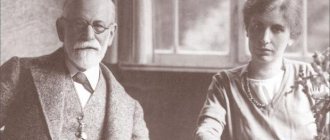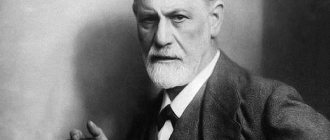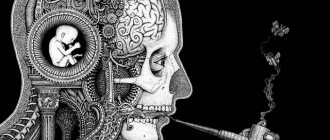Sigmund Freud (1856-1939) - Austrian psychologist, psychoanalyst, psychiatrist, founder of psychoanalysis and the psychoanalytic movement in general. In his research he made little use of the usual experimental approach, although he was convinced that his work was strictly scientific in nature. Freud also believed that analysis of patients' case histories and his own self-analysis provided sufficient basis for conclusions.
To a greater extent, S. Freud was interested in those subjects that, as a rule, had previously remained unattended: unconscious motivation of behavior, conflicts between the forces of the unconscious and their consequences for the human psyche.
Briefly about the theory
When Sigmund Freud took up psychoanalysis and presented his vision of mental problems to the world, the public received the teaching with hostility. The new theory contradicted all the canons: religion, science, philosophy, social foundations, culture. But, having originated at the end of the 19th century, the theory is still used by leading psychiatrists in the world.
The scientist dedicated his life to understanding the human psyche and identifying the components that motivate his actions. The main idea of the theory is the belief that the mental nature has no interruptions, and from one event the next is born.
It is not always possible to trace the chain of sequences. But what happened in childhood will definitely have an impact (albeit unconsciously) in later life. Freud's theory is briefly interpreted as follows: every action, desire, thought is a conscious or unconscious intention, “growing” from the past.
Note! The analyst’s task is to understand emotional experiences, find hidden connections between events and establish the true reasons for actions.
Summarizing
Freud's theory of psychoanalysis was briefly and clearly presented in this article. To summarize, we can say that this method is one of the attempts to understand those features of the human psyche that were previously incomprehensible . In the modern world, the term “psychoanalysis” is used in the following areas:
- As the name of a scientific discipline.
- A collective name for a set of events dedicated to research into the functioning of the psyche.
- As a method of treating neurotic disorders.
Many modern scientists often criticize Sigmund Freud's theory. However, today, the concepts that were introduced by these scientists are a kind of basis for the science of psychology.
What is classical psychoanalysis
Archetype - what is it in psychology and philosophy
Sigmund Freud founded a theory that allows us to interpret the unconscious motives of people's behavior. Classical psychoanalysis in the modern sense means:
- a discipline based on scientific research;
- a set of measures studying mental processes;
- a technique used in the treatment of neurotic disorders.
Therapy is based on communication between the doctor and the patient, during which the latter shares his dreams, thoughts, and associations. The specialist analyzes the collected information, trying to identify unconscious conflicts.
At an appointment with a psychoanalyst
Then the hypothesis is transformed and brought to a conscious, understandable level. In this form, it is transmitted to the subject, who must accept it on faith.
Major discoveries
Freud made several fundamental discoveries in the field of psychology, introducing new trends and concepts. These include:
- Unconscious. By the Unconscious, Freud understood a special area of the psyche, the presence of which a person is not aware of. The unconscious seeks to subjugate the will and relieve the human individual from the pressure of moral standards.
- Libido. Freud called it the engine of the individual's mental life. Libido activity affects ambitions and aspirations. Freud draws a parallel between sexual and social activity: a man’s libido is stronger than a woman’s, so he has a stronger need for sex and a desire for competition.
- Interpretation of dreams. The unconscious constantly tries to overpower the will of the individual and sends him signals reminding him of suppressed desires. A person receives these signals in the form of dreams. To get rid of anxiety, you need to analyze dreams and find the true causes of discomfort.
- Neuroticism. Freud grouped mental disorders caused by suppression of impulses into one group and called them nervous diseases or neuroticism. All people existing within European culture are susceptible to neuroticism, since they are distant from nature and are forced to constantly control their natural needs.
Not all contemporaries welcomed Freud's ideas; some criticized them. Karen Horney, an American psychoanalyst, in one of her works examined in detail Freud's theory of women's envy of the male penis and suggested that in fact a man is jealous of the presence of a uterus and the ability to reproduce, and the driving force of the human personality is not libido, but anxiety. Karen's bold views made her one of the iconic figures of neo-Freudianism.
What is included in the basis
Consciousness - what is it in psychology
Briefly, psychoanalysis can be presented as a method for studying psychological processes that are beyond consciousness. The theory takes into account the interrelation of all hypotheses about the functions and structure of the mental apparatus and considers them as a whole.
Modern psychoanalysis is based on the following areas:
- A theory that defines the behavior and development of an individual;
- Research of motives through free associations, interpretation of dreams. This allows us to bring out the hidden prerequisites that led to mental disorder;
- Treatment method, including:
- transfer and resistance analysis;
- interpretation of the source of conflicts (interpretation);
- elaboration as the final stage, leading to a restructuring of the psyche.
The main goal of the analyst is to rid the psyche of the subject of the hidden mechanisms that gave rise to conflict situations. This allows you to redirect the patient to the realization of positive desires and help him adapt to society.
What is hidden beyond consciousness
Additional Information. During the psychodynamic approach, the specialist tries to make the patient aware of the existence of unconscious conflicts, thereby influencing behavior and personal relationships.
Criticism
Throughout its existence, the psychoanalytic approach in psychology has been criticized from various points of view.
The main points of criticism:
- long course of therapy (Freud described a case where he conducted 1,017 sessions over 6 years of treating one patient);
- high risk of iatrogenic effects and conformism;
- ineffectiveness of short-term use;
- behavioral psychotherapy is 2 times more effective than psychoanalysis;
- the patient does not work on himself, he is completely dependent on the psychoanalyst;
- The irrationalism of the psychoanalytic trend is too confusing and not understandable to many people.
English biologist Peter Medawar called psychoanalysis the largest intellectual fraud of the twentieth century.
Despite all the criticism, the philosophy of psychoanalysis has played an important role in the development of society. It is actively used in almost all humanities. Without it, even the sexual revolution would have been impossible. Now this direction, represented by more than 20 schools and individual movements, is practiced as widely and often as it was a hundred years ago when it was created.
Theoretical foundations of psychoanalysis according to Freud
Psychology of human personality
The mental life of a person is represented by 3 levels, located vertically relative to each other. The study of these areas forms the basis of psychoanalysis.
Levels of the human psyche
| Region | Definitions |
| Unconscious | This area of the psyche is beyond consciousness and is based on instincts. Feelings, experiences, thoughts of a forbidden nature, as well as repressed memories can be hidden behind the “screen”. This part of the soul is timeless. Sometimes events from childhood can penetrate the consciousness, giving old memories new colors. |
| Preconscious | Defined as a memory lying on the surface of the unconscious area. Therefore, it is accessible and easily removed. This “warehouse” stores information about recent events. Here you can find pleasant memories, favorite melodies, professional skills, etc. |
| Consciousness | This area contains what a person feels, experiences, and realizes at a specific moment in his life. This part of the psyche is constantly updated. Previous elements of consciousness do not evaporate - some settle in the preconscious, others (the most unpleasant) go into deep oblivion and are stored in the unconscious until a certain moment |
To briefly describe Freud's theory, personality is an iceberg, which is based on instincts, drives, and psychic energy. The top is crowned with clear consciousness; underneath it lies a layer of preconscious mass.
Levels of the human psyche
Of all 3 areas, the unconscious part plays the main role in the individual’s psyche. A person is guided to achieve goals by instincts:
- the main one is vital energy (or libido), based on sexual nature;
- the death instinct is an aggressive component.
The amount of living energy, its appearance, distribution, movement influence the characteristics of behavior, thinking, experience, and also lead to mental disorders. The death instinct turns on defense mechanisms.
Unsatisfied desires and the phenomenon of sublimation
The division of the psyche into conscious and unconscious components leads to intrapsychological conflicts. Consciousness displaces bad desires and inclinations. But they do not disappear, but hide in the “bins” of the unconscious area.
Note! Due to dissatisfaction, tensions arise, which the psychoanalyst must cope with.
Ways to resolve internal conflicts
| Component | Peculiarities |
| Dreams | They reflect hidden, unfulfilled desires. When the same dream is repeated many times, it indicates a specific need. If a desire is not realized, it becomes an obstacle to self-expression. |
| Sublimation | Conscious redirection of vital energy from sexual topics to social, creative, intellectual goals. This is a certain form of protection of the psyche from internal conflicts. Sublimated energy can be called the engine of civilization |
| Compensation | To prevent unsatisfied desires from leading to an anxious state, they are neutralized. If energy cannot find a way out, it is redirected to overcome obstacles. Thanks to assertiveness and efficiency, a person achieves success |
| Protection | There are mechanisms in the psyche that begin to turn on against the background of emerging tensions. They suppress, distort, or deny the situation that is causing the conflict. |
The last component in overcoming internal mental tension prevents us from exploring the unconscious area. To cope with such a difficulty, Freudian psychology offers a method of analysis that helps the patient understand the cause of dissatisfaction and cope with the conflict.
Defense Mechanisms
Psychological tactics of the individual are aimed at smoothing out unpleasant affective states. Defense mechanisms keep conflicts at an unconscious level, preventing them from reaching the tip of the iceberg. Compensation and sublimation can be considered components of defensive tactics. In addition to them, the psyche also uses other mechanisms:
- projection helps shift responsibility onto other people, attributing your problems to them;
- substitution uses the redirection of aggression to another object, more unrequited and acceptable at the moment;
- regression returns to the pattern of behavior characteristic of the early period, less alarming;
- denial is ignoring a threat to life;
- suppression blocks consciousness or displaces disturbing moments from it;
- rationalization is an almost creative process that allows you to create a legend that justifies the real motives of your own behavior and the failures that have arisen;
- the reactive formation replaces the factors that provoked tension with the opposite ones.
Defense mechanism of the psyche
Not every individual is able to fully resist conflicts. It can be difficult to restrain defense mechanisms, which creates a risk of developing neurotic anxiety, the impulses of which can overwhelm the consciousness.
Psychosexual stages of personality development
Freud was convinced that the origins of neurotic disorders should be sought in the childhood experiences of patients. Thus, he became the first theorist to point out the importance of childhood research for understanding the nature of the psyche. In his opinion, the basic personality traits of a person are formed almost completely by the fifth year of life.
Z. Freud identified 5 stages of psychosexual development : oral stage (0-1.5 years), anal stage (1.5-3 years), phallic stage (3-6 years), latent stage (6-12 years), genital stage (12-18 years). Each of these stages is characterized by its own erogenous zone, its own neoplasms and its own characteristics.
The concept of “complex” in psychoanalysis
Human behavior is directly related to the development of the psyche. Its formation is influenced by attitudes, motives, and ideas. The totality of these components, formed in the unconscious area, is interpreted in psychology as a complex.
A combination of factors can be formed around any emotional state (affect). More often the complex is interpreted as something negative. Psychoanalysis examines several groups of similar formations that determine the conscious life of an individual.
Common complexes
| View | Definition |
| Oedipus (Electra) | Indicates the boy's sexual attraction to his mother, which provokes aggression towards his father. In the female interpretation, this is the Electra complex, when a girl is attracted to her dad |
| Inferiorities | Feelings of limited capabilities and personal insufficiency are common to many people. They are replaced by compensation - the desire for all kinds of successes, allowing them to prove their importance |
| Ions | Here the doubts that a person is not able to realize his abilities and achieve something in life come first. Against the backdrop of fears, the individual deliberately lowers his claims |
There are other complexes of a specific nature with the help of which one can interpret human behavioral reactions and mental processes.
Inferiority complex
Introduction
From ancient times to the present day, philosophy has steadily maintained a great interest in the problem of man. As the ancient Greek thinker Empedocles noted, man has always been, is and will be a more interesting phenomenon for man.
For a long time in philosophy, man was considered, as a rule, as a conscious being. The motives of human behavior and existence itself are considered only as a manifestation of conscious life. A person in this capacity acts like a reasonable person. At the same time, starting from the New Era, the problem of the unconscious occupies an increasingly important place in philosophy. Kant, Leibniz, Dostoevsky in Russia, from different points of view, begin to analyze the meaning and role of mental processes that are not consciously realized by man. Consciousness is an ideal phenomenon, a function, a special property, a product of a highly organized material substrate - the human brain, thinking matter.
The founder of psychoanalytic philosophy is the Austrian scientist Sigmund Freud. Psychoanalytic philosophy has evolved from the practice of psychotherapy into a general socio-philosophical theory. Freud, as a scientist, discovered, first of all, the unconscious and showed that it operates. Before Freud, neurosis was treated with hypnosis. Freud basically abandoned this method. And he began to treat with words, framing the procedure as a method of free association. The fact is that Freud considered psychoanalysis to be a strictly scientific theory. He reproached philosophers for speculative and unfounded constructions, while in his own teaching he saw a generalization of clinical experience. The main feature of the psychoanalytic concept of man is the statement that the unconscious is the area of the mental where processes occur that are essential and significant for human life, which determine the actions, motivations and experiences of a person. Freud and his followers Carl Gustav Jung and Erich Fromm considered it their task to identify the meaningful characteristics of the unconscious, in the depths of which, in their opinion, a special life takes place, not yet sufficiently studied and significant.
Sigmund Freud made huge strides in assessing and understanding the development of human society. He created the theory of psychoanalysis, he also made progress in understanding the human psyche and revealing its depths. S. Freud's theory found many followers. Many modern psychoanalysts actively use Freud's works in their research.
The "I" function in Freud's psychoanalysis
In Freud's theory of psychoanalytic analysis, there is such a thing as personality structure. Its goal is to maintain peace of mind, increase the level of satisfaction and reduce the degree of dissatisfaction. The model includes 3 systems, they are inseparable from each other.
Personality structure
| Function | Peculiarities |
| ID (or IT) | It is inherent in a person from birth and is interpreted as instincts or heredity. This function is disorganized and chaotic, not subject to the laws of logic, but has unlimited influence on other systems |
| EGO (I) | Appears from ID when the child begins to recognize himself as an individual. Both structures are interconnected and complement each other - the EGO protects the ID, and it feeds the I. The mechanism of such relationships can be understood using the example of sexual needs. IT is capable of satisfying desire through intimacy at any moment, but the EGO decides how and when this happens. In other words, the Self acts as a restraining (redirecting) function for ID. |
| Super-EGO (Super-I) | The most developed system responsible for compliance with laws and moral standards, setting blocks, restrictions and prohibitions. Freud identifies 3 functions characteristic of the Super-EGO: • conscience; • self-observation; • formation of ideals. |
All components of the personality structure direct efforts towards achieving one goal and are unthinkable without each other. In this three, the Self is the component that enters into relationships with other people. The super-EGO determines the boundaries of the behavior of the Self, on which the energy of the ID is reflected.
Personality structure
All components of the personal structure must adapt to external reality. This adjustment does not always go smoothly; it provokes conflicts within the individual.
Freudism in philosophy: basic principles and development
The progress of culture reduces human happiness and increases a person’s sense of guilt due to the limitation of his natural desires.
Carl Gustav Jung (1875-1961) - Swiss psychologist, cultural scientist, philosopher.
He revised Freud's ideas about the origin of human creativity and the development of human culture.
According to Jung, “libido” is not just some kind of sexual desire, but a flow of vital-psychic energy. Therefore, all phenomena of a person’s unconscious and conscious life are considered as different manifestations of a single libido energy.
This libido energy, under the influence of insurmountable life obstacles, is capable of “turning back”, leading to the reproduction in the human mind of images and experiences that are not associated with the experience of a given individual, but are primary Forms of adaptation to the world of the human race. The unconscious includes not only the individual and subjective, repressed beyond the threshold
consciousness, but, above all, it is a “collective” and impersonal mental content, rooted in ancient times.
Jung called these collective unconscious images archetypes.
Jung is not interested in cause-and-effect relationships, but synchronic ones. Therefore, its archetypes perform the functions of the foundations of the universe, and the fundamental structures of the human psyche, providing pre-experimental readiness to perceive and comprehend the world. Jung names the following archetypes of the collective unconscious: Child and Virgo, Mother and Rebirth, Spirit and Trickster (werewolf). The baby is a possible future; He is both God and hero; he is abandoned, unprotected, but developing in the direction of independence and invincibility.
Jung believes that the general structure of the personality is created by the archetype, and the spiritual life of the individual bears the archetypal imprint.
And although the archetype as a way of connecting images has been passed down from generation to generation since ancient times, it is always filled with specific content for each person. Archetypes structure the understanding of the world of ourselves and other people. They underlie creativity and contribute to the internal unity of human culture, making possible the interconnection of different eras of development and understanding of people.
Video
Real Chinese Milk Oolong Tea Green Leaf Ceremony (Milk Oolong Tea, Nai Xiang Jin Xuan, Golden Flower with Milk Aroma, Turquoise Tea), Light Milk Taste, 200 g.
389 ₽ More details
Real Chinese Milk Oolong Tea Green Loose Leaf Ceremony (Milk Oolong Tea, Nai Xiang Jin Xuan, Golden Flower, Turquoise Tea), Subtle Natural Taste, 100 g.
237 ₽ More details
Medical tweezers
Why did Freud need Thanatos and how does it explain the death drive?
In his next important theoretical work, the book Beyond the Pleasure Principle (1920), Freud had to revise some of the provisions of his theory.
The need to reform the theory arose in connection with the consequences of the First World War. The war neuroses that arose in combat veterans could not be explained through disturbances in the organization of libido, which were used to explain ordinary neuroses.
Freud's thoughts received a new stimulus when he saw a one-and-a-half-year-old child playing: he was throwing a reel tied to his hand by a thread. When the coil disappeared from the child’s field of vision, he shouted: “There!”, and pulling the coil towards himself, he stated: “Here.” Freud saw in this game a training in the general ability to be deprived and get used to the absence of an object, and in the reel - a symbol of treasure, from the mother to one’s own life.
Using this analogy, Freud explained the origin of war neuroses in people returning from the First World War: in his opinion, their ability to experience pain was not sufficiently trained. These people were not mentally prepared for the horrors they endured and for death in war.
In the same theory, Freud adds one more to the list of drives - the drive for peace. Freud associated it with the death drive, or Thanatos. Like libido (or Eros), Thanatos can be directed inward or outward—it is nirvana and aggression, respectively. Self-directed Thanatos is inextricably linked with self-directed Eros (or self-love), and outward-directed Thanatos is associated with outward-directed Eros (love of an external object). In fact, the doctrine of Thanatos became a continuation of the idea of narcissism, by which Freud understood self-love (the work of the libido directed towards the Self-object).
The idea of narcissism generally comes into contact with the most important philosophical teachings; it is not for nothing that Freud also uses the expression “principle of nirvana” with a reference to Buddhism for it. A very important skill for a person throughout his adult life is to have a positive attitude towards existence, to appreciate it in itself. Unfortunately, very often a person acquires this skill only in adulthood, when there is little existence left, and sometimes he does not acquire it at all.









